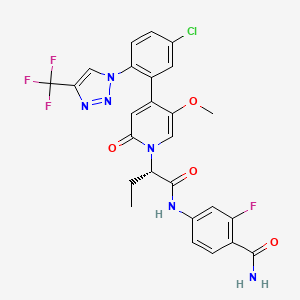Asundexian
Asundexian is an oral inhibitor of activated factor XI. Obviously, a deficiency of factor XI causes a rare type of hemophilia. For this reason, inhibiting factor XI has the effect of a blood thinner. there are animal data that show efficacy of this medication for the treatment of arterial and venous thrombosis. So, use of Asundexian has the potential to add to our options in the treatment of pulmonary embolism and deep vein thrombosis, atrial fibrillation and in patients after a myocardial infarction. In a press release, Beyer announced ambitious plans to study this medication through several studies.

Inhibiting Factor XI
There are trials on more than one factor XI inhibitor. The main reason is a recent understanding that factor XI plays a role in thrombosis and not only in hemostasis. It is interesting to note that inhibiting factor XI might be safer (from a bleeding perspective) than other types of blood thinners.
Current inhibitors utilize several mechanisms including monoclonal antibodies and small molecule inhibitors. Asundexian is a small molecule inhibitor.
Asundexian Metabolism
This medication comes in three doses: 10, 20 and 50 mg. It is not clear to me how it is eliminated from the body, despite reading about multiple pharmacological trials. But we do know that gut or liver metabolism do not affect the bioavailability of asundexian. It was also available in various formulations and with different gastric pH levels.
Asundexian After Myocardial Infarction
In a study called PACIFIC-AMI, patients with acute myocardial infarction were randomized to either receive Asundexian or not in addition to antiplatelet medications. The drug did not result in reduced efficacy events. On the other hand, there was no signal of excess bleeding in the trial arm.
Asundexian to Prevent Secondary Stroke
A study called PACIFIC-STROKE randomized patients after acute non-cardioembolic stroke to receive antiplatelet therapy with and without Asundexian. The study failed to show improved results with the trial drug. From a safety perspective, there were no excess bleeds in the study arm.
Atrial Fibrillation Trials
PACIFIC-AF was a study that compared Asundexian to apixaban in the treatment of atrial fibrillation. In this trial there were very few stroke events. But the study drug had fewer bleeds compared with apixaban. These results are particularly interesting, because two prior trials that I mentioned above – PACIFIC-STROKE and PACIFIC-AMI did not hit their mark.
The OCEANIC trial is a 30,000 patient study of Asundexian in atrial fibrillation. It is still ongoing.


Pingback: Anticoagulation in Renal Failure: Options and Complications